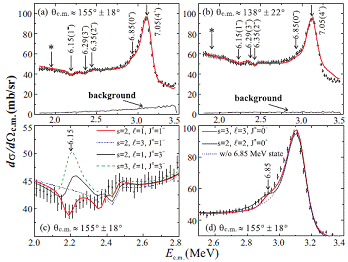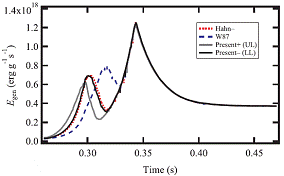The proton resonant properties of compound 18Ne nucleus have been investigated by researchers of nuclear astrophysics group at the Institute of Modern Physics, Chinese Academy of Sciences (IMP) using resonant elastic scattering of 17F+p. Here an inverse kinematics method was utilized, that is, a 17F radioactive ion (RI) beam bombarded a proton target. The experiment was performed by using CRIB at the Center for Nuclear Study, the University of Tokyo. A 61.9 MeV 17F RI beam was produced at CRIB and bombarded a thick H2 gas target. The recoiling light particles were measured by three ΔE-E silicon telescopes at laboratory angles of θlab ≈ 3°, 10°, and 18°. Five resonances at Ex = 6.15, 6.28, 6.35, 6.85, and 7.05 MeV were observed in the excitation functions (see Fig. 1), and their spin-parities have been determined based on an R-matrix analysis. In particular, Jπ = 1- was firmly assigned to the 6.15-MeV state which dominates the thermonuclear 14O(α, p)17F rate below 2 GK. As well, a possible new excited state in 18Ne was observed at Ex = 6.85 ± 0.11 MeV with tentative J = 0 assignment. This state could be the analog state of the 6.880 MeV (0−) level in the mirror nucleus 18O, or a bandhead state (0+) of the six-particle four-hole (6p-4h) band. A new thermonuclear 14O(α, p)17F rate has been determined, and the astrophysical impact of multiple recent rates has been examined by using an XRB model (see Fig. 2). Contrary to previous expectations, researchers find only a modest impact of using reaction rates differing by up to several orders of magnitude on predicted nuclear energy generation rates from. The results have been published in Phys. Rev. C90 (2014) 025803. 
Fig.1 The center-of-mass differential cross sections for elastically scattered protons of 17F+p at angles of (a) θc.m. ≈ 155° ± 18°, and (b) θc.m. ≈ 138° ± 22°. The (red or gray) solid curved lines represent the best overall R-matrix fits. The locations of inelastic scattering events for the 6.15-MeV state are indicated as the asterisks. The indicated background spectra (from the Ar gas run) were subtracted accordingly. Additional R-matrix fits for the 6.15- and 6.85-MeV states are shown in (c) and (d), respectively. (Image by IMP) 
Fig.2 Nuclear energy generation rates during one-zone XRB calculations. (Image by IMP) |

